High Strain Rates Impact Performance of Glass Fiber-Reinforced Polymer Impregnated with Shear-Thickening Fluid
Abstract
:1. Introduction
2. Experiments and Methods
2.1. Materials
2.2. STF Preparation and Rheological Response
2.3. Impregnation of GFRP and Microscopy Analysis
2.4. SHPB Impact Test Setup and Procedures
3. Results and Discussion
3.1. Impact Response of GFRP–STF Specimen under High Strain Rate
3.2. Influence of Laying Angle on the Strain-Rate Effect of GFRP–STF Specimen
3.3. Influence of Layer Number on the Strain-Rate Effect of GFRP–STF Specimen
4. Conclusions
Author Contributions
Funding
Institutional Review Board Statement
Informed Consent Statement
Data Availability Statement
Acknowledgments
Conflicts of Interest
References
- Sun, L.; Wei, M.; Zhang, N. Experimental study on the behavior of GFRP reinforced concrete columns under eccentric axial load. Constr. Build. Mater. 2017, 152, 214–225. [Google Scholar] [CrossRef]
- Wei, M.; Sun, L.; Zhang, C.; Wang, Q. Effect of seawater exposure on compressive behavior of concrete columns reinforced longitudinally with glass fiber reinforced polymer bars. J. Compos. Mater. 2018, 52, 2289–2299. [Google Scholar] [CrossRef]
- Daelemans, L.; Cohades, A.; Meireman, T.; Beckx, J.; Spronk, S.; Kersemans, M.; De Baere, I.; Rahier, H.; Michaud, V.; Van Paepegem, W.; et al. Electrospun nanofibrous interleaves for improved low velocity impact resistance of glass fibre reinforced composite laminates. Mater. Des. 2018, 141, 170–184. [Google Scholar] [CrossRef]
- Li, Z.; Khennane, A.; Hazell, P.J.; Brown, A.D. Impact behaviour of pultruded GFRP composites under low-velocity impact loading. Compos. Struct. 2017, 168, 360–371. [Google Scholar] [CrossRef]
- Hasan-nezhad, H.; Yazdani, M.; Salami-Kalajahi, M.; Jeddi, M. Mechanical behavior of 3D GFRP composite with pure and treated shear thickening fluid matrix subject to quasi-static puncture and shear impact loading. J. Compos. Mater. 2020, 54, 3933–3948. [Google Scholar] [CrossRef]
- Hasan-nezhad, H.; Yazdani, M.; Jeddi, M. High- and low-velocity impact experiments on treated STF/3D glass fabrics. Thin Walled Struct. 2022, 171, 108720. [Google Scholar] [CrossRef]
- Jeddi, M.; Yazdani, M. Dynamic compressive response of 3D GFRP composites with shear thickening fluid (STF) matrix as cushioning materials. J. Compos. Mater. 2021, 55, 2151–2164. [Google Scholar] [CrossRef]
- Jeddi, M.; Yazdani, M.; Hasannezhad, H. Experimental study on puncture resistance of 2D and 3D glass fabrics reinforced with shear thickening fluid (STF). AUT J. Mech. Eng. 2022, 6, 3. [Google Scholar]
- Balali, E.; Kordani, N.; Sadough Vanini, A. Response of glass fiber-reinforced hybrid shear thickening fluid (STF) under low-velocity impact. J. Text. Inst. 2017, 108, 376–384. [Google Scholar] [CrossRef]
- Wei, M.; Sun, L.; Zhu, J. Effects of parameters controlling the impact resistance behavior of the GFRP fabric impregnated with a shear thickening fluid. Mater. Des. 2020, 196, 109078. [Google Scholar] [CrossRef]
- Sun, L.; Wei, M.; Zhu, J. Low velocity impact performance of fiber-reinforced polymer impregnated with shear thickening fluid. Polym. Test. 2021, 96, 107095. [Google Scholar] [CrossRef]
- Selver, E. Impact and damage tolerance of shear thickening fluids-impregnated carbon and glass fabric composites. J. Reinf. Plast. Compos. 2019, 38, 669–688. [Google Scholar] [CrossRef]
- Wagner, N.J.; Brady, J.F. Shear thickening in colloidal dispersions. Phys. Today 2009, 62, 27–32. [Google Scholar] [CrossRef]
- Wei, M.; Sun, L.; Zhang, C.; Qi, P.; Zhu, J. Shear-thickening performance of suspensions of mixed ceria and silica nanoparticles. J. Mater. Sci. 2019, 54, 346–355. [Google Scholar] [CrossRef]
- Gürgen, S.; Kuşhan, M.C.; Li, W. Shear thickening fluids in protective applications: A review. Prog. Polym. Sci. 2017, 75, 48–72. [Google Scholar] [CrossRef]
- Waitukaitis, S.R.; Jaeger, H.M. Impact-activated solidification of dense suspensions via dynamic jamming fronts. Nature 2012, 487, 205–209. [Google Scholar] [CrossRef]
- Majumdar, A.; Butola, B.S.; Srivastava, A. An analysis of deformation and energy absorption modes of shear thickening fluid treated Kevlar fabrics as soft body armour materials. Mater. Des. 2013, 51, 148–153. [Google Scholar] [CrossRef]
- Qin, J.; Guo, B.; Zhang, L.; Wang, T.; Zhang, G.; Shi, X. Soft armor materials constructed with Kevlar fabric and a novel shear thickening fluid. Compos. Part B-Eng. 2020, 183, 107686. [Google Scholar] [CrossRef]
- Mawkhlieng, U.; Majumdar, A. Deconstructing the role of shear thickening fluid in enhancing the impact resistance of high-performance fabrics. Compos. Part B-Eng. 2019, 175, 107167. [Google Scholar] [CrossRef]
- Gürgen, S.; de Sousa, R.J.A. Rheological and deformation behavior of natural smart suspensions exhibiting shear thickening properties. Arch. Civ. Mech. Eng. 2020, 20, 110. [Google Scholar] [CrossRef]
- Baharvandi, H.R.; Khaksari, P.; Alebouyeh, M.; Alizadeh, M.; Khojasteh, J.; Kordani, N. Investigating the quasi-static puncture resistance of p-aramid nanocomposite impregnated with the shear thickening fluid. J. Reinf. Plast. Compos. 2014, 33, 2064–2072. [Google Scholar] [CrossRef]
- Tian, T.; Nakano, M. Design and testing of a rotational brake with shear thickening fluids. Smart Mater. Struct. 2017, 26, 035038. [Google Scholar] [CrossRef]
- Gürgen, S.; Sofuoğlu, M.A. Experimental investigation on vibration characteristics of shear thickening fluid filled CFRP tubes. Compos. Struct. 2019, 226, 111236. [Google Scholar] [CrossRef]
- Wei, M.; Lin, K.; Liu, H. Experimental investigation on hysteretic behavior of a shear thickening fluid damper. Struct. Control Health Monit. 2019, 26, e2389. [Google Scholar] [CrossRef]
- Wei, M.; Hu, G.; Jin, L.; Lin, K.; Zou, D. Forced vibration of a shear thickening fluid sandwich beam. Smart Mater. Struct. 2016, 25, 055041. [Google Scholar] [CrossRef]
- Wu, X.; Xiao, K.; Yin, Q.; Zhong, F.; Huang, C. Experimental study on dynamic compressive behaviour of sandwich panel with shear thickening fluid filled pyramidal lattice truss core. Int. J. Mech. Sci. 2018, 138–139, 467–475. [Google Scholar] [CrossRef]
- Yeh, S.-K.; Zhuang, H.-Y.; Chen, Y.-C.; Tseng, P.-C.; Zheng, J.-Y.; Yang, L.-Y.; Lee, K.-C.; Chen, Y.-L. High-velocity impact performance of shear-thickening fluid/kevlar composites made by the padding process. Polym. Compos. 2019, 40, 3040–3049. [Google Scholar] [CrossRef]
- Lyu, B.H.; He, Q.K.; Chen, S.H.; Shao, Q.; Chen, Y.; Geng, Z.Y. Experimental study on shear thickening polishing of cemented carbide insert with complex shape. Int. J. Adv. Manuf. Technol. 2019, 103, 585–595. [Google Scholar] [CrossRef]
- Gürgen, S.; Sert, A. Polishing operation of a steel bar in a shear thickening fluid medium. Compos. Part B-Eng. 2019, 175, 107127. [Google Scholar] [CrossRef]
- Zhang, X.; Wang, P.; Kurkin, A.; Chen, Q.; Gong, X.; Zhang, Z.; Yang, E.-H.; Yang, J. Mechanical response of shear thickening fluid filled composite subjected to different strain rates. Int. J. Mech. Sci. 2021, 196, 106304. [Google Scholar] [CrossRef]
- Nayak, P.; Ghosh, A.K.; Bhatnagar, N. Study of dynamic compressive responses of ultra-high molecular weight polyethylene felt impregnated with shear thickening fluid. Polym. Compos. 2021, 42, 6736–6748. [Google Scholar] [CrossRef]
- Chen, W.W.; Song, B. Split Hopkinson (Kolsky) Bar: Design, Testing and Applications; Springer Science & Business Media: Berlin/Heidelberg, Germany, 2010. [Google Scholar]
- Zhong, W.; Rusinek, A.; Jankowiak, T.; Abed, F.; Bernier, R.; Sutter, G. Influence of interfacial friction and specimen configuration in Split Hopkinson Pressure Bar system. Tribol. Int. 2015, 90, 1–14. [Google Scholar] [CrossRef]
- Song, B.; Chen, W. Dynamic stress equilibration in split Hopkinson pressure bar tests on soft materials. Exp. Mech. 2004, 44, 300–312. [Google Scholar] [CrossRef]
- Xiang, X.M.; Lu, G.; You, Z. Energy absorption of origami inspired structures and materials. Thin Walled Struct. 2020, 157, 107130. [Google Scholar] [CrossRef]
- Zhang, X.; Wang, P.; Sun, D.; Li, X.; An, J.; Yu, T.X.; Yang, E.-H.; Yang, J. Dynamic plastic deformation and failure mechanisms of individual microcapsule and its polymeric composites. J. Mech. Phys. Solids 2020, 139, 103933. [Google Scholar] [CrossRef]

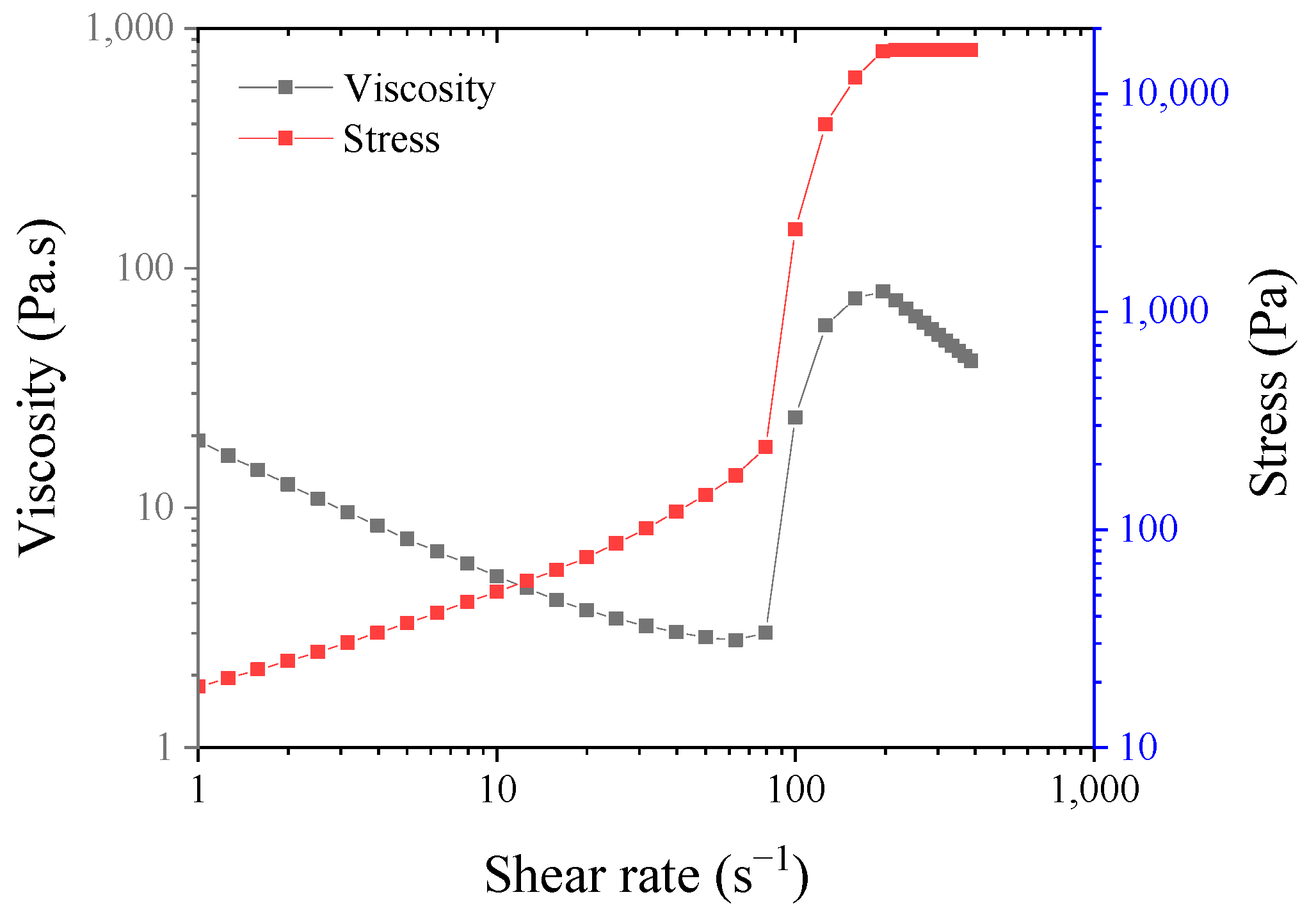
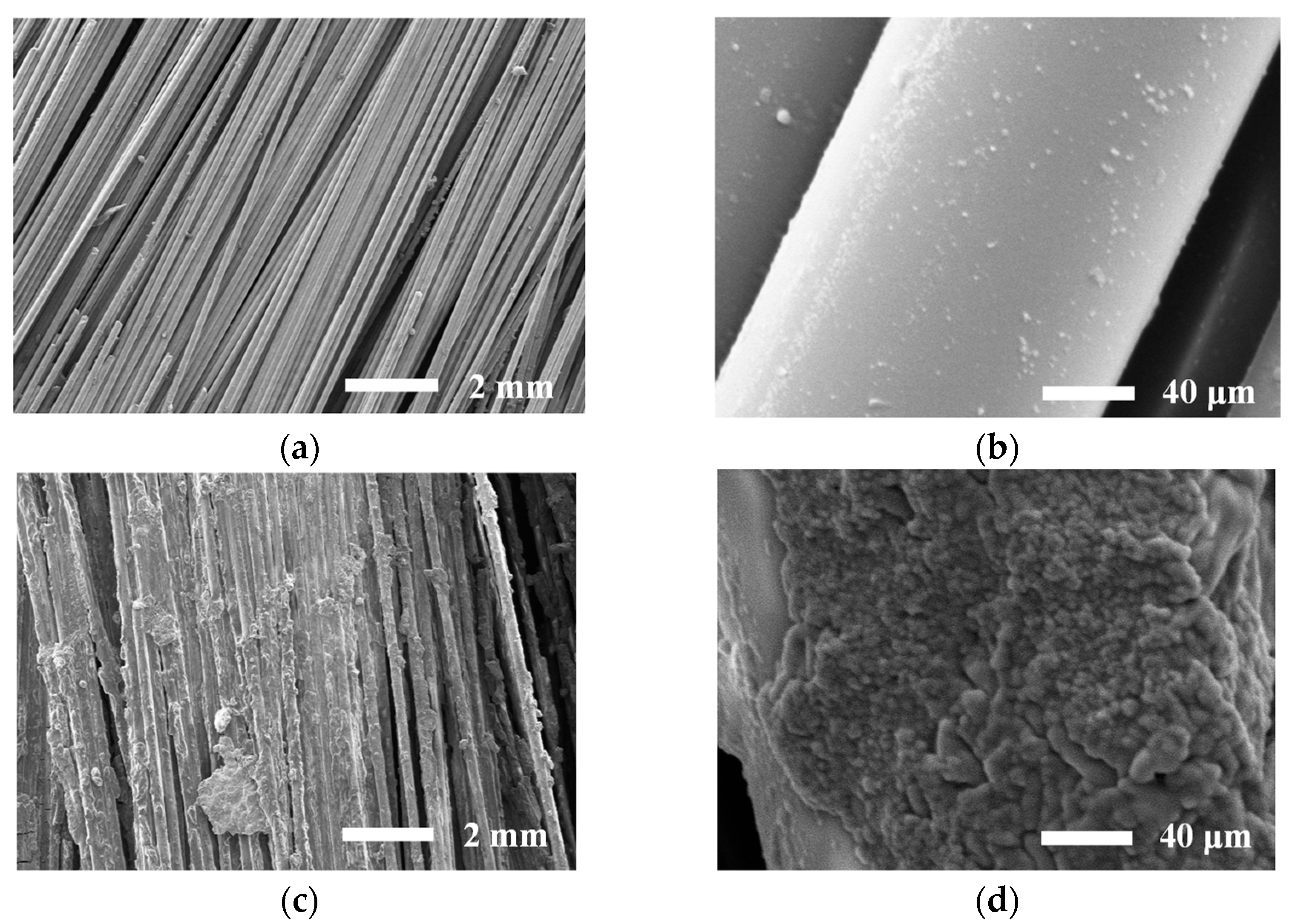
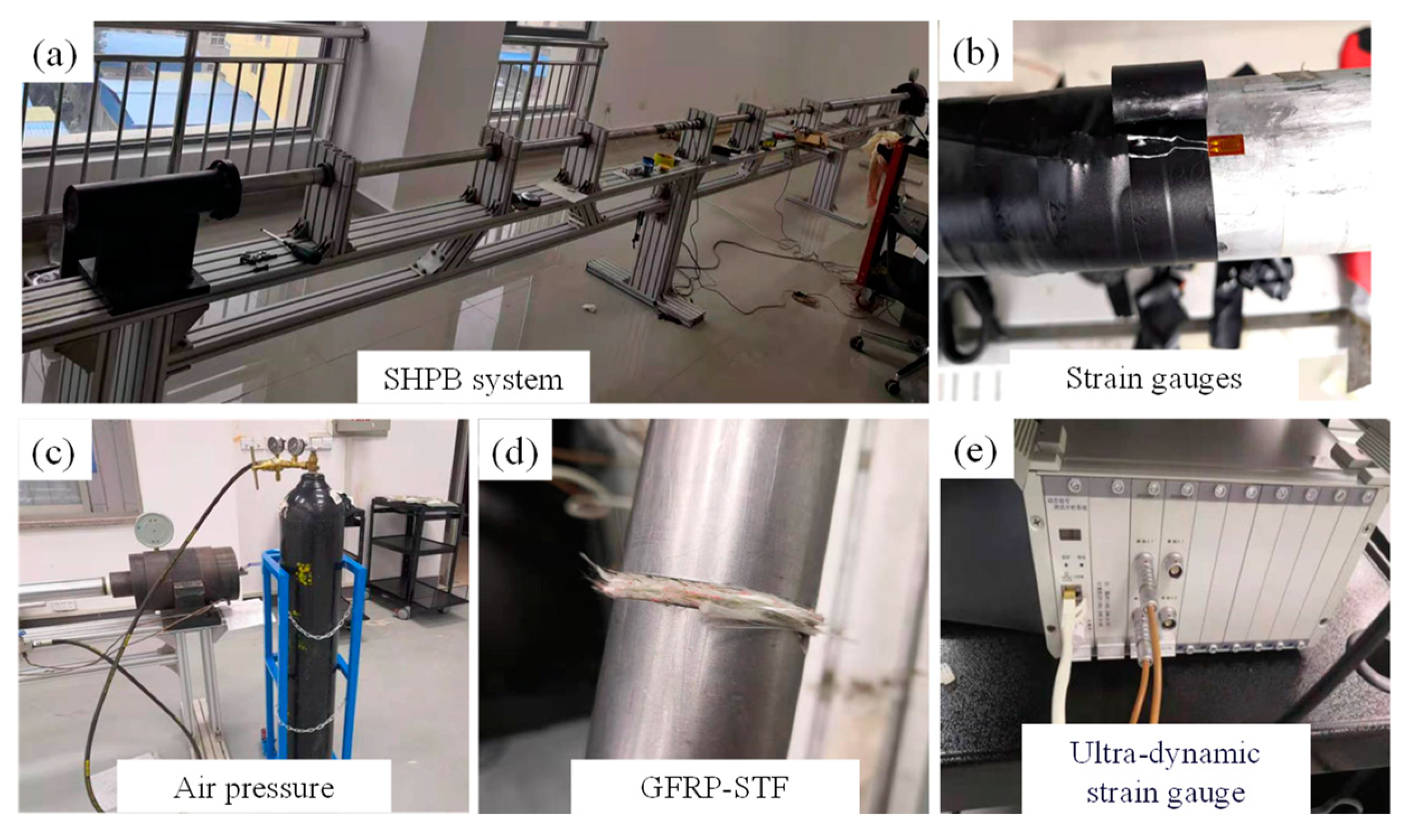
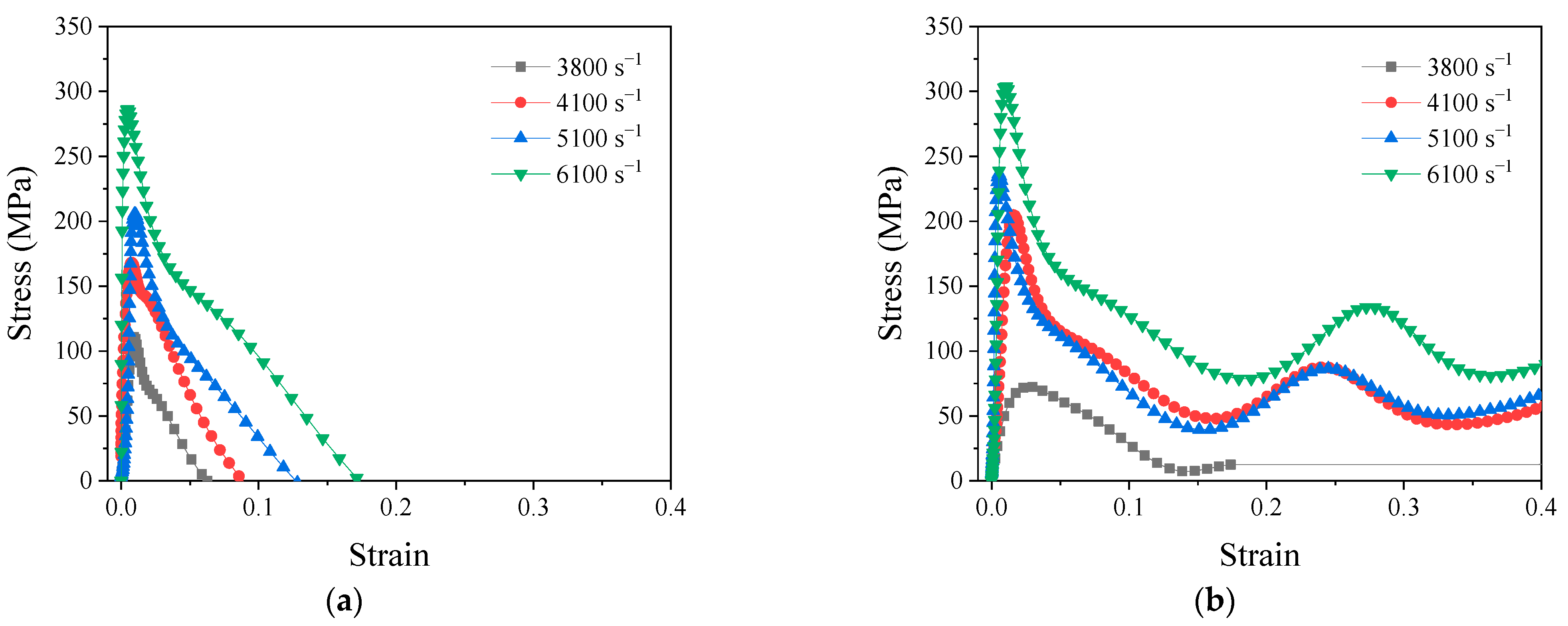
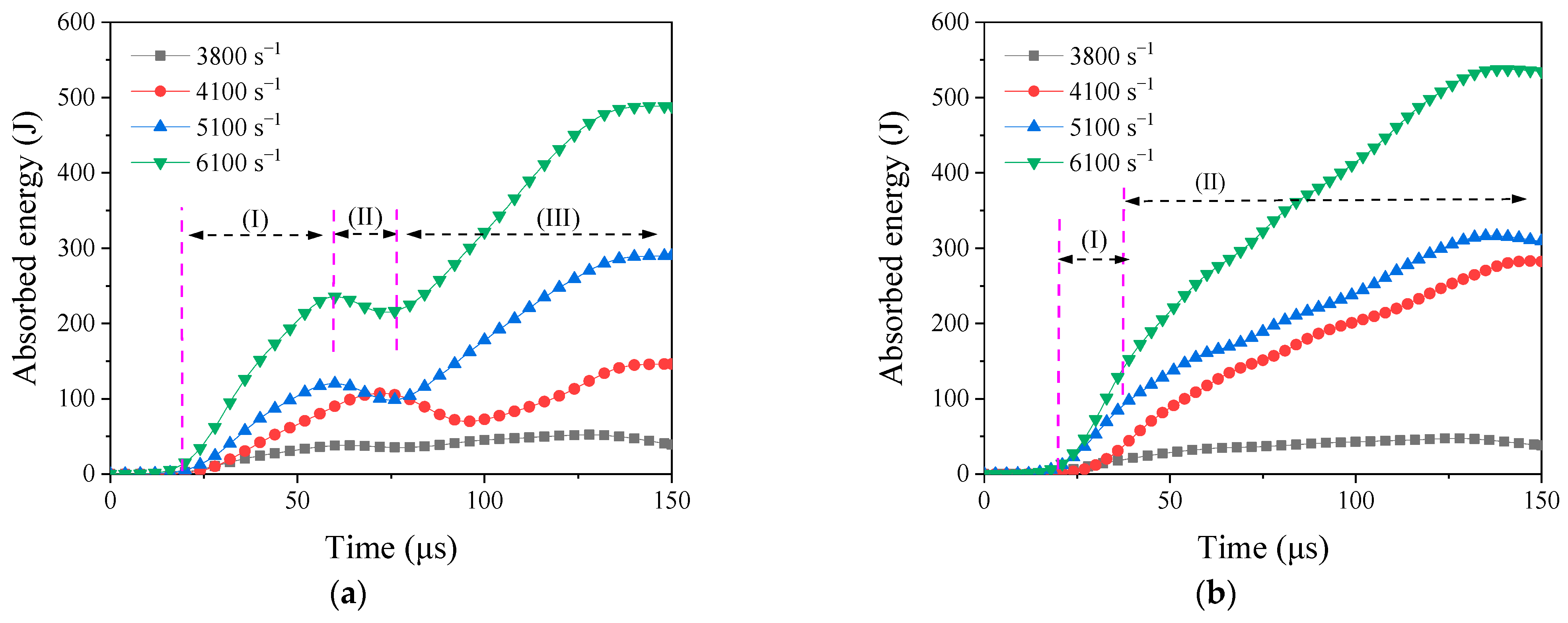



| Strain Rates (s−1) | Peak Stress (MPa) | Peak Absorption Energy (J) | ||||
|---|---|---|---|---|---|---|
| 20%-3-0° | 20%-3-45° | 20%-3-45° | 20%-3-0° | 20%-3-45° | 20%-3-90° | |
| 3800 | 46.9 | 108 | 72.4 | 52.2 | 76.6 | 47.3 |
| 4100 | 125.3 | 227.2 | 204.8 | 161.6 | 272.8 | 282.8 |
| 5100 | 237.6 | 255.5 | 236.5 | 239.4 | 352.9 | 376.4 |
| 6100 | 267.3 | 322 | 303.9 | 472.7 | 507.4 | 537.7 |
| Strain Rates (s−1) | Peak Stress (MPa) | Peak Absorption Energy (J) | ||||
|---|---|---|---|---|---|---|
| 20%-3-90° | 20%-4-90° | 20%-5-90° | 20%-3-90° | 20%-4-90° | 20%-5-90° | |
| 3800 | 72.4 | 81.7 | 111 | 47.3 | 275.6 | 301.1 |
| 4100 | 204.8 | 211 | 227 | 282.8 | 413.4 | 620.1 |
| 5100 | 236.5 | 255.9 | 272 | 376.4 | 475.6 | 665.3 |
| 6100 | 303.9 | 304 | 307 | 537.7 | 597.7 | 762.8 |
Disclaimer/Publisher’s Note: The statements, opinions and data contained in all publications are solely those of the individual author(s) and contributor(s) and not of MDPI and/or the editor(s). MDPI and/or the editor(s) disclaim responsibility for any injury to people or property resulting from any ideas, methods, instructions or products referred to in the content. |
© 2023 by the authors. Licensee MDPI, Basel, Switzerland. This article is an open access article distributed under the terms and conditions of the Creative Commons Attribution (CC BY) license (https://creativecommons.org/licenses/by/4.0/).
Share and Cite
Wei, M.; Sun, L.; Gu, W. High Strain Rates Impact Performance of Glass Fiber-Reinforced Polymer Impregnated with Shear-Thickening Fluid. J. Compos. Sci. 2023, 7, 208. https://doi.org/10.3390/jcs7050208
Wei M, Sun L, Gu W. High Strain Rates Impact Performance of Glass Fiber-Reinforced Polymer Impregnated with Shear-Thickening Fluid. Journal of Composites Science. 2023; 7(5):208. https://doi.org/10.3390/jcs7050208
Chicago/Turabian StyleWei, Minghai, Li Sun, and Wanjin Gu. 2023. "High Strain Rates Impact Performance of Glass Fiber-Reinforced Polymer Impregnated with Shear-Thickening Fluid" Journal of Composites Science 7, no. 5: 208. https://doi.org/10.3390/jcs7050208





